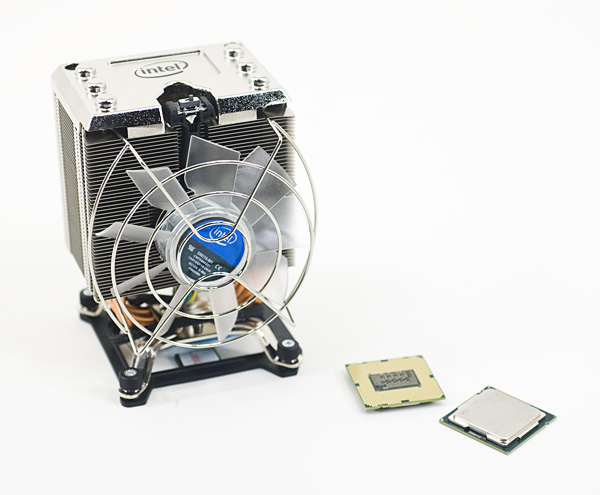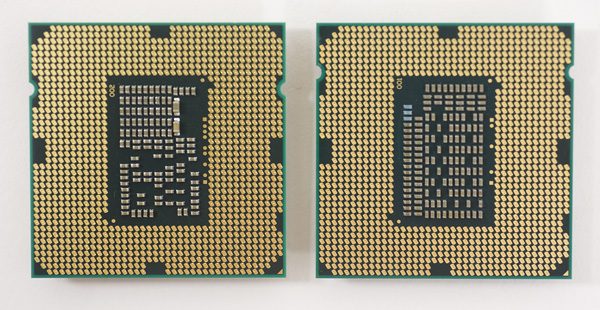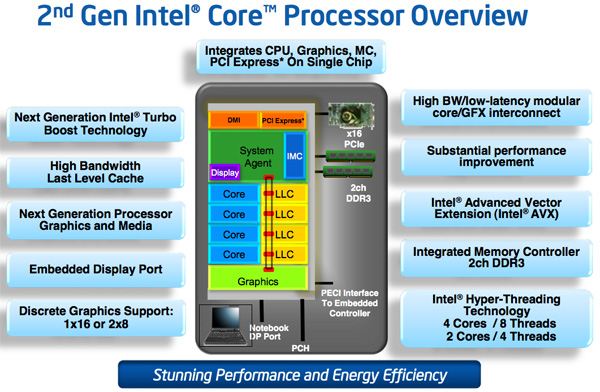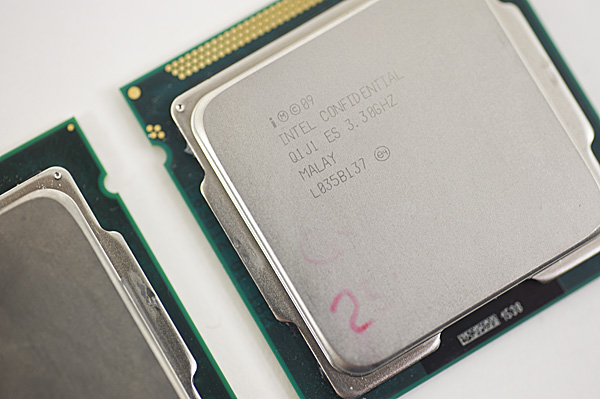The Sandy Bridge Review: Intel Core i7-2600K, i5-2500K and Core i3-2100 Tested
by Anand Lal Shimpi on January 3, 2011 12:01 AM ESTIntel never quite reached 4GHz with the Pentium 4. Despite being on a dedicated quest for gigahertz the company stopped short and the best we ever got was 3.8GHz. Within a year the clock (no pun intended) was reset and we were all running Core 2 Duos at under 3GHz. With each subsequent generation Intel inched those clock speeds higher, but preferred to gain performance through efficiency rather than frequency.
Today, Intel quietly finishes what it started nearly a decade ago. When running a single threaded application, the Core i7-2600K will power gate three of its four cores and turbo the fourth core as high as 3.8GHz. Even with two cores active, the 32nm chip can run them both up to 3.7GHz. The only thing keeping us from 4GHz is a lack of competition to be honest. Relying on single-click motherboard auto-overclocking alone, the 2600K is easily at 4.4GHz. For those of you who want more, 4.6-4.8GHz is within reason. All on air, without any exotic cooling.
Unlike Lynnfield, Sandy Bridge isn’t just about turbo (although Sandy Bridge’s turbo modes are quite awesome). Architecturally it’s the biggest change we’ve seen since Conroe, although looking at a high level block diagram you wouldn’t be able to tell. Architecture width hasn’t changed, but internally SNB features a complete redesign of the Out of Order execution engine, a more efficient front end (courtesy of the decoded µop cache) and a very high bandwidth ring bus. The L3 cache is also lower and the memory controller is much faster. I’ve gone through the architectural improvements in detail here. The end result is better performance all around. For the same money as you would’ve spent last year, you can expect anywhere from 10-50% more performance in existing applications and games from Sandy Bridge.
I mentioned Lynnfield because the performance mainstream quad-core segment hasn’t seen an update from Intel since its introduction in 2009. Sandy Bridge is here to fix that. The architecture will be available, at least initially, in both dual and quad-core flavors for mobile and desktop (our full look at mobile Sandy Bridge is here). By the end of the year we’ll have a six core version as well for the high-end desktop market, not to mention countless Xeon branded SKUs for servers.
The quad-core desktop Sandy Bridge die clocks in at 995 million transistors. We’ll have to wait for Ivy Bridge to break a billion in the mainstream. Encompassed within that transistor count are 114 million transistors dedicated to what Intel now calls Processor Graphics. Internally it’s referred to as the Gen 6.0 Processor Graphics Controller or GT for short. This is a DX10 graphics core that shares little in common with its predecessor. Like the SNB CPU architecture, the GT core architecture has been revamped and optimized to increase IPC. As we mentioned in our Sandy Bridge Preview article, Intel’s new integrated graphics is enough to make $40-$50 discrete GPUs redundant. For the first time since the i740, Intel is taking 3D graphics performance seriously.
| CPU Specification Comparison | ||||||||
| CPU | Manufacturing Process | Cores | Transistor Count | Die Size | ||||
| AMD Thuban 6C | 45nm | 6 | 904M | 346mm2 | ||||
| AMD Deneb 4C | 45nm | 4 | 758M | 258mm2 | ||||
| Intel Gulftown 6C | 32nm | 6 | 1.17B | 240mm2 | ||||
| Intel Nehalem/Bloomfield 4C | 45nm | 4 | 731M | 263mm2 | ||||
| Intel Sandy Bridge 4C | 32nm | 4 | 995M | 216mm2 | ||||
| Intel Lynnfield 4C | 45nm | 4 | 774M | 296mm2 | ||||
| Intel Clarkdale 2C | 32nm | 2 | 384M | 81mm2 | ||||
| Intel Sandy Bridge 2C (GT1) | 32nm | 2 | 504M | 131mm2 | ||||
| Intel Sandy Bridge 2C (GT2) | 32nm | 2 | 624M | 149mm2 | ||||
It’s not all about hardware either. Game testing and driver validation actually has real money behind it at Intel. We’ll see how this progresses over time, but graphics at Intel today very different than it has ever been.
Despite the heavy spending on an on-die GPU, the focus of Sandy Bridge is still improving CPU performance: each core requires 55 million transistors. A complete quad-core Sandy Bridge die measures 216mm2, only 2mm2 larger than the old Core 2 Quad 9000 series (but much, much faster).
As a concession to advancements in GPU computing rather than build SNB’s GPU into a general purpose compute monster Intel outfitted the chip with a small amount of fixed function hardware to enable hardware video transcoding. The marketing folks at Intel call this Quick Sync technology. And for the first time I’ll say that the marketing name doesn’t do the technology justice: Quick Sync puts all previous attempts at GPU accelerated video transcoding to shame. It’s that fast.
There’s also the overclocking controversy. Sandy Bridge is all about integration and thus the clock generator has been moved off of the motherboard and on to the chipset, where its frequency is almost completely locked. BCLK overclocking is dead. Thankfully for some of the chips we care about, Intel will offer fully unlocked versions for the enthusiast community. And these are likely the ones you’ll want to buy. Here’s a preview of what’s to come:
The lower end chips are fully locked. We had difficulty recommending most of the Clarkdale lineup and I wouldn’t be surprised if we have that same problem going forward at the very low-end of the SNB family. AMD will be free to compete for marketshare down there just as it is today.
With the CPU comes a new platform as well. In order to maintain its healthy profit margins Intel breaks backwards compatibility (and thus avoids validation) with existing LGA-1156 motherboards, Sandy Bridge requires a new LGA-1155 motherboard equipped with a 6-series chipset. You can re-use your old heatsinks however.

Clarkdale (left) vs. Sandy Bridge (right)
The new chipset brings 6Gbps SATA support (2 ports) but still no native USB 3.0. That’ll be a 2012 thing it seems.













283 Comments
View All Comments
-=Hulk=- - Monday, January 3, 2011 - link
That's crazy, are the chipsets PCI-e line still limited to v1 (250MB/s) speed or what????http://images.anandtech.com/reviews/cpu/intel/sand...
mino - Monday, January 3, 2011 - link
No, you read it wrong.There are altogether 8 PCIE 2.0 linex and all can be used independently, aka s as "PCIe x1".
The CPU-Chipset bandwith however is a basic PCIe x4 link, so do not expect wonders is more divices are in heavy use ...
-=Hulk=- - Monday, January 3, 2011 - link
No!Look at the PCI-e x16 from the CPU. Intel indicates a bandwidth of 16GB/s per line. That means 1GB/s per line.
But PCI-e v2 has a bandwidth of 500MB/s per line only. Thats mean that the values that Intel Indicates for the PCI-e lines are the sum of the upload AND download bandwidth of the PCI-e.
Thats means that the PCI-e lines of the chipset run at 250MB/s speed! That is the bandwidth of the PCI-e v1, and Intel has done the same bullshit with the P55/H57, he indicates that they are PCI-e v2 but they limits their speed to the values of the PCI-e v1:
P55 chipset (look at the 2.5GT/s !!!) :
"PCI Express* 2.0 interface:
Offers up to 2.5GT/s for fast access to peripheral devices and networking with up to 8 PCI Express* 2.0 x1 ports, configurable as x2 and x4 depending on motherboard designs.
http://www.intel.com/products/desktop/chipsets/p55... "
P55, also 500MB/s per line as for the P67
http://benchmarkreviews.com/images/reviews/motherb...
Even for the ancient ICH7 Intel indicates 500MB/s per line, but at that time PCI-e v didn't even exist... That's because it's le sum of the upload and download speed of the PCI-e v1.
http://img.tomshardware.com/us/2007/01/03/the_sout...
DanNeely - Monday, January 3, 2011 - link
Because 2.0 speed for the southbridge lanes has been reported repeatedly (along with a 2x speed DMI bus to connect them), my guess is an error when making the slides with bidirectional BW listed on the CPU and unidirectional BW on the southbridge.jmunjr - Monday, January 3, 2011 - link
Intel's sell out to big media and putting DRM in Sandy Bridge means I won't be getting one of these puppies. I don't care how fast it is...Exodite - Monday, January 3, 2011 - link
Uh, what exactly are you referencing?If it's TXT it's worth noting that the interesting chips, the 2500K and 2600K, doesn't even support it.
chirpy chirpy - Tuesday, January 11, 2011 - link
I think the OP is referring to Intel Insider, the not-so-secret DRM built into the sandy bridge chips. I can't believe people are overlooking the fact that Intel is attempting to introduce DRM at the CPU level and all everyone has to say is "wow, I can't WAIT to get one of dem shiny new uber fast Sandy Bridges!"I for one applaud and welcome our benevolent DRM overlords.....
http://www.pcmag.com/article2/0,2817,2375215,00.as...
nuudles - Monday, January 3, 2011 - link
I have a q9400, if I compare it to the 2500K in bench and average (straight average) all scores the 2500K is 50% faster. The 2500K has a 24% faster base clock, so all the architecture improvements plus faster RAM, more cache and turbo mode gained only ~20% or so on average, which is decent but not awesome taking into account the c2q is 3+ year old design (or is it 4 years?). I know that the idle power is significantly lower due to power gating so due to hurry up and wait it consumes less power (cant remember c2q 45nm load power, but it was not much higher than this core 2011 chips).So 50%+ faster sounds good (both chips occupy the same price bracket), but after equating clock speeds (yes it would increase load and idle power on the c2q) the improvement is not massive but still noticeable.
I will be holding out for Bulldozer (possibly slightly slower, especially in lightly threaded workloads?) or Ivy Bridge as mine is still fast enough to do what I want, rather spend the money on adding a SSD or better graphics card.
7Enigma - Monday, January 3, 2011 - link
I think the issue with the latest launch is the complete and utter lack of competition for what you are asking. Anand's showed that the OC'ing headroom for these chips are fantastic.....and due to the thermals even possible (though not recommended by me personally) on the stock low-profile heatsink.That tells you that they could have significantly increased the performance of this entire line of chips but why should they when there is no competition in sight for the near future (let's ALL hope AMD really produces a winner in the next release) or we're going to be dealing with a plodding approach with INTEL for a while. In a couple months when the gap shrinks (again hopefully by a lot) they simply release a "new" batch with slightly higher turbo frequencies (no need to up the base clocks as this would only hurt power consumption with little/no upside), and bam they get essentially a "free" release.
It stinks as a consumer, but honestly probably hurts us enthusiasts the least since most of us are going to OC these anyways if purchasing the unlocked chips.
I'm still on a C2D @ 3.85GHz but I'm mainly a gamer. In a year or so I'll probably jump on the respin of SDB with even better thermals/OC potential.
DanNeely - Monday, January 3, 2011 - link
CPUs need to be stable in Joe Sixpack's unairconditioned trailer in Alabama during August after the heatsink is crusted in cigarette tar and dust, in one of the horrible computer desks that stuff the tower into a cupboard with just enough open space in the back for wires to get out; not just in an 70F room where all the dust is blown out regularly and the computer has good airflow. Unless something other than temperature is the limiting factor on OC headroom that means that large amounts of OCing can be done easily by those of us who take care of their systems.Since Joe also wants to get 8 or 10 years out of his computer before replacing it the voltages need to be kept low enough that electromigration doesn't kill the chip after 3 or 4. Again that's something that most of us don't need to worry about much.